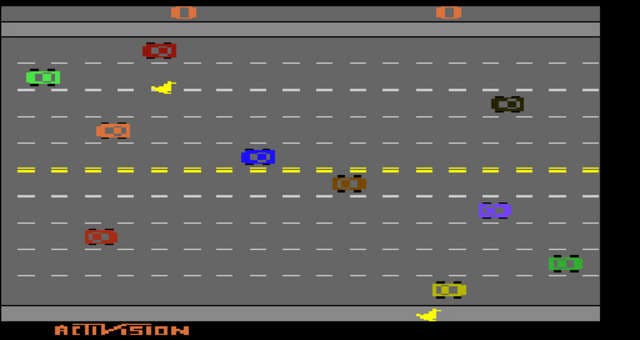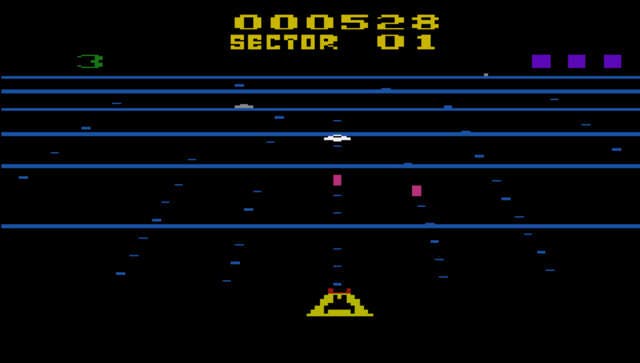Activision Hits Remixed
2600 games. Actually, not quite that many.
I'm really glad I missed most of the all-conquering Atari 2600 era. Not because most of the games were unforgivably rubbish, but because they cost an absolute fortune. I clearly recall my chocolate-stained fingers pressed up against the glass display case in Woolies, looking longingly at games like Pitfall and Enduro, and crying inside at the £29.99 price tag. If I didn't eat sweets, catch a bus or read any comics for 10 weeks in a row I might be able to afford one if I was lucky. But ten weeks in the life of a nine-year-old is too long to comprehend, so I settled for the hand-me-down copy of Space Invaders, Night Driver and Centipede and wasted my money in the arcade instead. A far better idea, as it turned out.
So when people bleat like tortured lambs about shelling out for full priced games today, think of the poor children that lived in a shoebox in the middle of the road in 1982. Kids today. Don't know they're born. Tut.
Back in olden times when there were only three television channels, no remote controls and country-wide blackouts, buying every single game on this here Activision 'hits' package would have set you back well over a thousand pounds. Today, lucky lucky lucky souls that you are, the cost to you will be less than £20. That's the sort of price we like to pay for time travel.

Historians will recall that Activision was basically born out of the dissatisfaction with the Atari business model that didn't allow third party publishers to release games for its system. Despite the inevitable litigation, Activision went ahead and did so anyway, and enjoyed some massive hits in the process. Between 1981 and 1984, the company unleashed over 40 titles - which this budget-priced compilation rounds up in exhaustive style.
Giving an in-depth journey into some of the earliest home videogames hits (officially the second generation), this package will have gamers of a certain vintage (i.e. mainly those of us over 30) weeping. Whether those tears will be salty drops of woe at having your illusions roundly shattered, or diamonds of nostalgic joy depends on your powers of remembrance, general interest levels and forgiveness at a technology generation that was already fairly dated at the time these games appeared.
Shooters
Mirroring the international obsession with shoot-'em-ups that existed at the start of the '80s, it's perhaps not surprising that around a third of this compilation is littered with simple shooters. Most of them are simple clones of the big arcade hits of the time, or variations on a theme. For example, Robot Tank does a reasonable take on BattleZone, Chopper Command does Defender in a helicopter, while Spider Fighter isn't a million miles away from Centipede. Elsewhere, Megamania does Space Invaders with scrolling aliens, Demon Attack is Space Invaders again, while others try their best to inject scenario variation by simply changing the kind of craft you're shooting from.
Horizontal scrolling shooter Seaquest finds you shooting from a submarine, Plaque Attack puts the player inside a person's mouth while trying to defend their teeth from invading junk food (rather like Imagine's Molar Maul if you ever played that on the Spectrum), while Crackpots tasks you with throwing Petunias at the bugs coming out of the sewers below. Imaginative enough scenarios, but exceptionally simple gameplay that makes it hard to stomach playing many of these games for more than a few minutes. But enjoyment isn't really the point is it? It's about nostalgia and having a laugh at how things used to be while MP3s of Soft Cell and Men Without Hats play over the top - even while the game itself is playing.

Towards the end of the 2600's lengthy life span, vertical shooters like River Raid showed infinitely more ambition than most of the games here, with scrolling landscapes that really pushed the ridiculously limited technology within the ageing console. Even now it's pretty smooth and playable, albeit in that typically unforgiving way. The sequel doesn't fare quite as well, though, with its fiddly altitude-based targeting system that instantly makes the core shooting aspect a bit of a faff. Elsewhere, there are some real dogs, like Beamrider with its laughable pseudo 3D scaling attempt, while it's hard to even fathom if there's an actual game to be had in Starmaster. The trouble with having so many games to wade through is if they aren't immediately playable, the temptation is to quickly move on. So we did.
Driving
There are just three driving games on offer in the collection, and given the 2600's woeful graphical capabilities, it's not hard to see why. Grand Prix, for example does a pretty appalling job at top-down racing, where the basic gameplay involves merely steering between lines of cars moving in a straight line. Dragster, meanwhile, does the whole shebang side-on, with a horrible manual gear change system that makes it alarmingly easy to blow your engine if you dare to over rev for half a second. Enduro - to my eyes at least - seemed like a big title when it came out, and is definitely a good contender for the best driving game on the 2600. With smooth sprite scaling and decent controls, it's surprisingly adept at what it does - but even so, your eyes might start bleeding after a while.

